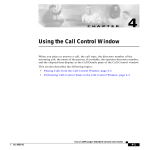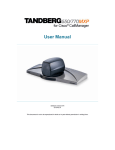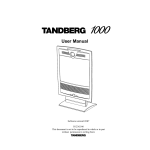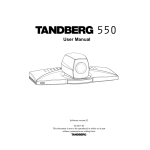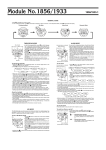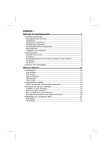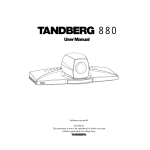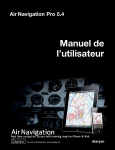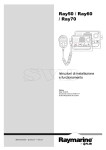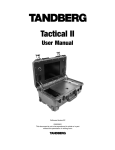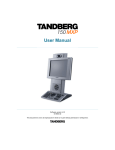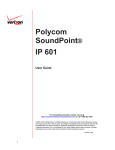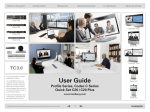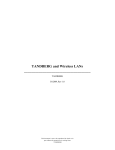Download TANDBERG MXP 550 User's Manual
Transcript
TANDBERG 1000 TANDBERG 550 for Cisco CallManager User Manual Software version H1/I1 D13293-02 This document is not to be reproduced in whole or in part without permission in writing from: TANDBERG 1000/550 for Cisco CallManager Trademarks and copyright COPYRIGHT © 2004, TANDBERG Philip Pedersensvei 22 1366 Lysaker, Norway, Tel: +47 67 125 125, Fax: +47 67 125 234 All rights reserved. This document contains information that is proprietary to TANDBERG. No part of this publication may be reproduced, stored in a retrieval system, or transmitted, in any form, or by any means, electronically, mechanically, by photocopying, or otherwise, without the prior written permission of TANDBERG. Nationally and internationally recognized trademarks and tradenames are the property of their respective holders and are hereby acknowledged. Portions of this software are © 1996-2003 RADVision Ltd. All intellectual property rights in such portions of the Software and documentation are owned by RADVision and are protected by United States copyright laws, other applicable copyright laws and international treaty provisions. RADVision and its suppliers retain all rights not expressly granted. Disclaimer The information in this document is furnished for informational purposes only, is subject to change without prior notice, and should not be construed as a commitment by TANDBERG. The information in this document is believed to be accurate and reliable, however TANDBERG assumes no responsibility or liability for any errors or inaccuracies that may appear in this document, nor for any infringements of patents or other rights of third parties resulting from its use. No license is granted under any patents or patent rights of TANDBERG. This document was written by the Technical Support Department of TANDBERG, Norway. We are committed to maintaining a high level of quality in all our documentation. Towards this effort, we welcome your comments and suggestions regarding the content and structure of this document. Please fax or mail your comments and suggestions to the attention of: Product Support Department TANDBERG, Philip Pedersensvei 22 1366 Lysaker, Norway Tel: +47 67 125 125 Fax: +47 67 125 234 Environmental Issues Thank you for buying a product which contributes to a reduction in pollution and thereby helps save the environment. Our products reduce the need for travel and transport and thereby reduce pollution. Our products have either none or few consumable parts (chemicals, toner, gas, paper). Our products are low energy consuming products. Battery handling: Batteries for the Remote Control are Long Life and Alkaline batteries saving the environment, please follow guidelines on the packing material for handling and disposal of the batteries. Waste handling: No need to send material back to TANDBERG as there are no consumables to take care of. Please contact your local dealer for information on recycling the product by sending the main parts of the product for disassembly at local electronic waste stations, marking recyclable parts so the waste station can disassemble and re-use these parts. Production of products: Our factories employ the most efficient environmental methods for reducing waste and pollution and ensuring the products are recyclable. 2 TANDBERG 1000/550 for Cisco CallManager Operator Safety Summary For your protection, please read these safety instructions completely before operating the equipment and keep this manual for future reference. The information in this summary is intended for operators. Carefully observe all warnings, precautions and instructions both on the apparatus and in the operating instructions. Equipment Markings The lightning flash symbol within an equilateral triangle is intended to alert the user to the presence of uninsulated “dangerous voltages” within the product’s enclosure that may be of sufficient magnitude to constitue a risk of electrical shock. The exclamation mark within an equilateral triangle is intended to alert the user to the presence of important operating and maintenance (servicing) instructions within literature accompanying the equipment. Warnings Water and moisture - Do not operate the equipment under or near water - for example near a bathtub, kitchen sink, or laundry tub, in a wet basement, or near a swimming pool or in areas with high humidity. Cleaning - Unplug the apparatus from the wall outlet before cleaning or polishing. Do not use liquid cleaners or aerosol cleaners. Use a lint-free cloth lightly moistened with water for cleaning the exterior of the apparatus. Ventilation - Do not block any of the ventilation openings of the apparatus. Install in accordance with the installation instructions. Never cover the slots and openings with a cloth or other material. Never install the apparatus near heat sources such as radiators, heat registers, stoves, or other apparatus (including amplifiers) that produce heat. Grounding or Polarization - Do not defeat the safety purpose of the polarized or grounding-type plug. A polarized plug has two blades with one wider than the other. A grounding type plug has two blades and a third grounding prong. The wide blade or third prong is provided for your safety. If the provided plug does not fit into your outlet, consult an electrician. Power-Cord Protection - Route the power cord so as to avoid it being walked on or pinched by items placed upon or against it, paying particular attention to the plugs, receptacles, and the point where the cord exits from the apparatus. Attachments - Only use attachments as recommended by the manufacturer. Accessories - Use only with a cart, stand, tripod, bracket, or table specified by the manufacturer, or sold with the apparatus. When a cart is used, use caution when moving the cart/apparatus combination to avoid injury from tip-over. Lightning - Unplug this apparatus during lightning storms or when unused for long periods of time. ISDN cables - CAUTION - To reduce the risk of fire, use only No. 26 AWG or larger telecommunication line cord. Servicing - Do not attempt to service the apparatus yourself as opening or removing covers may expose you to dangerous voltages or other hazards, and will void the warranty. Refer all servicing to qualified service personnel. Damaged Equipment - Unplug the apparatus from the outlet and refer servicing to qualified personnel under the following conditions: When the power cord or plug is damaged or frayed If liquid has been spilled or objects have fallen into the apparatus If the apparatus has been exposed to rain or moisture If the apparatus has been subjected to excessive shock by being dropped, or the cabinet has been damaged If the apparatus fails to operate in accordance with the operating instructions LCD Display The TANDBERG 1000 is equipped with a high quality LCD display. Nevertheless, due to the complex production process and the high resolution with nearly 1,500,000 pixels, defect pixels may occur resulting in black pixels or bright dots of constant color red, green or blue. As for any other product with an LCD, these defect pixels are more or less visible depending on the nature of the picture. But since the LCD features an extra bright LCD allowing an unusual wide view angle range, bright dots may be more visible than for regular laptops. All units are subject to thorough inspection to ensure that the LCD is well within the quality guaranteed by the manufacturer SHARP. 3 TANDBERG 1000/550 for Cisco CallManager Contents Introduction ..............................................................................................7 Menu structure ........................................................................................8 Installation ................................................................................................9 Precautions .............................................................................................................9 Connecting Your TANDBERG 1000 for Cisco CallManager System ................... 9 Power Cable ................................................................................................................................ 10 LAN Cable .................................................................................................................................... 10 Wireless LAN - Insert PC Card .................................................................................................... 10 Connecting Your TANDBERG 550 for Cisco CallManager System ..................... 11 Microphone Cable ....................................................................................................................... 12 Monitor Cable(s) .......................................................................................................................... 12 Power Cable ................................................................................................................................ 13 LAN Cable .................................................................................................................................... 13 Wireless LAN - Insert PC Card .................................................................................................... 13 Getting Started .........................................................................................14 Before You Begin ....................................................................................................14 Welcome Screen ..................................................................................................... 14 Softbuttons ..............................................................................................................14 Standby Mode ......................................................................................................... 14 Remote Control ....................................................................................................... 15 Handling Calls ......................................................................................................... 16 4 TANDBERG 1000/550 for Cisco CallManager Placing a Call .............................................................................................................................. 16 Answering a Call ......................................................................................................................... 16 Ending a Call ............................................................................................................................... 16 General Use ..............................................................................................17 Adjusting Volume ....................................................................................................17 View Outgoing Video (Selfview) .............................................................................17 Microphone on/off ...................................................................................................17 Speaker on/off ......................................................................................................... 17 Controlling the Camera ........................................................................................... 18 Moving / zooming Camera ......................................................................................................... 18 On Screen Symbols ................................................................................................ 18 Advanced Use ..........................................................................................19 Main Menu ................................................................................................................19 Calls .............................................................................................................................................. 20 Placing a Call on Hold ............................................................................................................... 20 Resuming a Call on Hold ........................................................................................................... 20 Transferring a Call to Another Extension .................................................................................... 20 Redialing the Last Number Dialled ............................................................................................ 21 Services ........................................................................................................................................ 21 Directory ....................................................................................................................................... 21 Settings ........................................................................................................................................ 22 View Status .............................................................................................................................. 22 System Status ..................................................................................................................... 23 Call Status ........................................................................................................................... 23 View Current Settings .......................................................................................................... 24 Restore Default Settings ...................................................................................................... 24 Network Settings ...................................................................................................................... 25 IP Settings ........................................................................................................................... 25 5 TANDBERG 1000/550 for Cisco CallManager Wireless LAN Settings ......................................................................................................... 27 TFTP Settings ...................................................................................................................... 28 DNS Settings ....................................................................................................................... 28 Audio Settings .......................................................................................................................... 29 Video Call Alert Tone / Alert Volume ..................................................................................... 29 Video Settings .......................................................................................................................... 29 Camera Brightness .............................................................................................................. 29 Monitor Brightness ............................................................................................................... 29 Whitebalance ....................................................................................................................... 30 Data Port Settings .................................................................................................................... 30 Messages ...................................................................................................................................... 30 Peripheral Equipment .............................................................................31 T1000 for Cisco CallManager Peripheral Equipment ........................................... 31 PC-interface (serial cable) .......................................................................................................... 31 Headset Interface ........................................................................................................................ 31 Kensington Lock .......................................................................................................................... 32 T550 for Cisco CallManager Peripheral Equipment ............................................. 32 PC-interface (serial cable) .......................................................................................................... 32 Appendices ..............................................................................................33 Appendix 1: IP Password .......................................................................................33 Appendix 2: Declaration of Conformity .................................................................34 Index .........................................................................................................36 6 TANDBERG 1000/550 for Cisco CallManager Introduction This User Manual is provided to help you make the best use of your TANDBERG unit. The TANDBERG 550/1000 for Cisco CallManager offers superior audio and video quality in a fully-featured unit. Application features · Delivers the ultimate visual communication experience, with video quality developed by TANDBERG for business video applications · Full range of Cisco IP telephony functions, including Directory and Call Control, as supported by the Cisco Call Manager · Software upgradeable, to grow with the capabilities of the Cisco CallManager · Includes XML applications which deliver a range of information services to the desk top · Interoperability with ISDN networks via the Cisco CallManager gateway function Performance features · Bandwidth up to 768 kbps · PC card slot for wireless LAN connection TIP IN THIS GUIDE, WE’VE INCLUDED HELPFUL TIPS AND NOTES. THEY APPEAR LIKE THIS. 7 TANDBERG 1000/550 for Cisco CallManager Menu structure menu The on-screen menu structure is shown below. Press MENU to enter or leave the Main Menu. Main Menu Calls Services Directory Settings Messages Missed Calls View Status Received Calls Network Settings Placed Calls Audio Settings Corporate Directory Video Settings Exit System Status Call Status View Current Settings Data Port Settings Restore Default Settings TFTP Settings IP Settings Camera Brightness DNS Settings Monitor Brightness Wireless LAN Settings White Balance OK Press UP/DOWN/LEFT/RIGHT to navigate. Press OK to select. 8 TANDBERG 1000/550 for Cisco CallManager Installation Installation Precautions • • • • • • • • • • Never install telephone wiring during a lightning storm. Never install telephone jacks in wet locations unless the jack is specifically designed for wet locations. Never touch uninstalled telephone wires or terminals unless the telephone line has been disconnected at the network interface. Use caution when installing or modifying telephone lines. Avoid using a telephone (other than a cordless type) during an electrical storm. There may be a remote risk of electrical shock from lightning. Do not use the telephone to report a gas leak in the vicinity of the leak. The socket outlet shall be installed near to the equipment and shall be easily accessible. Never install cables without first switching the power OFF. 1TR6 network type is not approved for connection directly to the telecommunications network. This network type is only to be used behind a PABX. This product complies with directives: LVD 73/23/EC, EMC 89/366/EEC, R&TTE 99/5/EEC Connecting Your TANDBERG 1000 for Cisco CallManager System 9 Installation TANDBERG 1000/550 for Cisco CallManager Power Cable • Connect the power supply to the ‘DC in’ input on the system. • Connect the power cable to the power supply. • Connect the power cable to an electrical distribution socket. LAN Cable • Connect a LAN cable from the ‘Ethernet’ connector on the system to your LAN. Wireless LAN - Insert PC Card • Remove the “dummy” card by pressing the ‘Eject’ button next to the slot. • Insert the Wireless LAN PC Card. NOTE MAKE SURE YOU INSERT THE CARD IN THE RIGHT DIRECTION (SEE DRAWING). PUSH THE CARD INTO THE SLOT UNTIL THE ‘EJECT’ BUTTON POPS UP. See ‘Wireless LAN Settings’ for configuration. 10 TANDBERG 1000/550 for Cisco CallManager Installation Connecting Your TANDBERG 550 for Cisco CallManager System Camera Microphone Remote Control 11 Codec Installation TANDBERG 1000/550 for Cisco CallManager Microphone Cable • Connect the microphone to the microphone cable. • Connect the microphone cable to the microphone input on the TANDBERG 550 for Cisco CallManager. Monitor Cable(s) Scart (Europe): • Connect the Scart adapter to one of the Scart connectors on your monitor. Scart (Europe) & RCA/S-Video (US): Audio: The cable with one RCA connector on one side and two RCA connectors on the other side: • Connect the two RCA connectors to your monitor (or Scart adapter) Audio Left/Right connectors (the audio signal from the system is a monaural signal and therefore is fed into both audio-in sockets on the monitor). • Connect the other end to ‘Audio Out’. Video: • Connect the S-video cable to the S-video connector on your monitor ( or Scart adapter). If you do not have an S-video connector on your monitor, connect the RCARCA video cable to the RCA connector on your monitor. • Connect the other end to ‘Video Out’. 12 TANDBERG 1000/550 for Cisco CallManager Installation Power Cable • Connect the power supply to the ‘DC in’ input on the system. • Connect the power cable to the power supply. • Connect the power cable to an electrical distribution socket. LAN Cable • To use the system on LAN, connect a LAN cable from the ‘Ethernet’ connector on the system to your LAN. Wireless LAN - Insert PC Card • Remove the “dummy” card by pressing the ‘Eject’ button next to the slot. • Insert the Wireless LAN PC Card. NOTE MAKE SURE YOU INSERT THE CARD IN THE RIGHT DIRECTION (WITH THE PRODUCT LOGO POINTING UPWARDS). PUSH THE CARD INTO THE SLOT UNTIL THE ‘EJECT’ BUTTON POPS UP. See ‘Wireless LAN Settings’ for configuration. 13 Getting started TANDBERG 1000/550 for Cisco CallManager Getting Started Before You Begin Chances are, your system administrator or a technician will connect your new TANDBERG unit to the corporate IP network. If that is not the case, please make sure that the system administrator has registered your unit on the Cisco Call Manager. Welcome Screen When turning on your TANDBERG unit, the following screen will appear. This screen provide you with the telephone number(s) assigned to your unit. Softbuttons The three color-coded commands shown at the bottom of the screen are called softbuttons and correspond with the quick-keys on the remote control. This means that to make a call, you can press the yellow quick-key. TIP IF THERE ARE MORE THAN THREE SOFTBUTTONS AVAILABLE, THERE WILL BE AN ARROW SYMBOL ON THE LEFT AND/OR RIGHT SIDE OF THE SOFTBUTTON SYMBOLS. USE THE LEFT AND RIGHT CURSOR BUTTONS ON THE REMOTE TO ACCESS THE OTHER SOFTKEYS. Standby Mode Your system will enter standby mode if unused for some time. In standby mode the screen will be dimmed. Pressing any key or picking up the remote control will wake up the system. An incoming call will also wake up the system. 14 TANDBERG 1000/550 for Cisco CallManager Getting Started Remote Control The remote control is used to handle calls and to navigate the graphical user interface. Quick keys The three buttons on top of the remote control refer to the blocks at the bottom of the screen. The text inside the blocks will change depending on which menu is selected and the state of the call. The three Quick keys have different colors. Camera control and menu navigation keys Frequently used keys allowing you to control your own camera and the far end camera, control your volume, select and move self-view, switch your microphone off and navigate in the menu system. Dialing keys Used to make a call. The twelve number keys, (0-9), #, * operate in the same way as on a modern push-button telephone. These buttons are also used when entering a name into a text field. On the T1000 for Cisco CallManager only Push-button The push-button in front of the system works as the CONNECT button during an incoming call. When in a call, the button toggles the speaker on/off. When the speaker is off, the audio is available on the headset output, marked ‘Headset’, on the back of the system. 15 Getting started TANDBERG 1000/550 for Cisco CallManager Handling Calls Placing a Call There are three ways to place a call: A. Use the NewCall softbutton. A dialing tone is heard and the desired number can be entered. To delete a digit, use the << soft-button. To cancel the number entry, use the EndCall softbutton or press DISCONNECT. When the required number of digits has been entered the call will proceed automatically. B. Just start entering the number using the number keys. No dialing tone will be heard in this case. To delete a digit use the <<. When the required number of digits has been entered press the Dial softbutton and the call will proceed. C. Press CONNECT. A dialing tone is heard and the desired number can be entered. To delete a digit, use the << soft-button. To cancel the number entry, use the EndCall softbutton or press DISCONNECT. When the required number of digits has been entered the call will proceed automatically. NOTE USING THE CONNECT BUTTON ONLY WORKS FOR THE FIRST CALL MADE. IT WILL NOT WORK IF YOU ARE TRYING TO INITIATE A SECOND CALL WHILE HAVING ANOTHER CALL ON HOLD. Answering a Call connect To answer a call, use the Answer softbutton or press CONNECT. TIP ON T1000 FOR CISCO CALLMANAGER THE PUSHBUTTON AT THE FRONT OF THE SYSTEM CAN BE USED TO ANSWER Ending a Call disconnect To end a call, use the EndCall softbutton or press DISCONNECT. 16 TANDBERG 1000/550 for Cisco CallManager General use General Use Adjusting Volume + Press the VOLUME keys to adjust the volume level. An on-screen indicator will show the current level. - View Outgoing Video (Selfview) selfview Press the SELFVIEW key to view your outgoing video. To change the image being viewed on the monitor during a call press SELFVIEW once. move pip Press MOVE PIP to move your selfview as a Picture-in-Picture to different corners of the screen or to switch it off. Microphone on/off mic off To mute your microphone, press MIC OFF. An on screen indicator will appear. Press MIC OFF to activate the microphone again. Speaker on/off To switch off your speaker in a call, press the push-button at the front of the system. An indicator will appear. The headset output, marked ‘Audio out’, on the back of the system will then provide the audio of the system. The push-button can also be used to accept a call. 17 TANDBERG 1000/550 for Cisco CallManager General use On Screen Symbols The system has a number of symbols signalling different settings. Indicates that the volume is turned off on the system. Indicates that the microphone is muted/turned off. Indicates that there is one or more new voice mail messages pending. Controlling the Camera Moving / zooming Camera To control the Camera use the keys below: OK for pan/tilt and zoom for zooming. NOTE THE TANDBERG 1000 FOR CISCO CALLMANAGER CAMERA IS EQUIPPED WITH DIGITAL ZOOM. WHEN YOU ZOOM IN, THE RESOLUTION OF THE IMAGE WILL DECREASE, SOMETIMES CAUSING THE SELFVIEW IMAGE TO LOOK A BIT UNSHARP. THIS EFFECT HOWEVER WILL HARDLY BE NOTICEABLE ON THE RECEIVED IMAGE AT THE FAR END. 18 TANDBERG 1000/550 for Cisco CallManager Advanced Use Advanced Use Main Menu menu The menu system can be used to select available functions and utilities for the system. To enter the menu system and the main menu, press the MENU key. You may leave the menu system at any time by pressing the MENU key. TIP A MENU STRUCTURE MAP IS PROVIDED IN THE SECTION ‘MENU STRUCTURE’ NOTE IF NO SPEED DIALS ARE ASSIGNED TO YOUR UNIT THE COLUMN MARKED ‘SPEED DIALS’ WILL NOT BE SHOWN. SIMILARLY, IF A SECOND EXTENSION NUMBER IS NOT ASSIGNED TO YOUR UNIT, THE COLUMN NAMED ‘LINES’ WILL NOT BE DISPLAYED. The items shown under the ‘Main Menu’ column will be explained in more detail over the next pages. The softbuttons available under the Main Menu window are Calls, Directory and Sleep Mode. Calls and Directory are explained in more detail later. Sleep Mode gives you the choice to put the unit in sleep mode now, in 60 minutes or in three hours. Lines The extension numbers assigned to your unit are shown under the ‘Lines’ column. To dial from one of your multiple lines, press the number on the remote key pad that corresponds with your desired extension and dial the number you want to reach. Speed Dials You can assign up to four speed dials on your unit. To use the speed dial just press the number on the remote key pad that correponds to the number you want to reach. 19 Advanced Use TIP TANDBERG 1000/550 for Cisco CallManager INSTEAD OF USING THE NUMBER KEYS TO ACCESS THE LINES OR SPEED DIALS YOU CAN HIGHLIGHT THE DESIRED FIELD USING THE NAVIGATION KEYS ON THE REMOTE CONTROL AND THEN PRESS OK. Calls The calls menu shows the state of the current calls. If you are in multiple calls, use the up/down navigation keys on the remote to ‘select’ a call. The three softbuttons on the screen will change according to the state the selected call is in. TIP THE CALLS MENU WILL AUTIMATICALLY POP UP ON THE SCREEN WHENEVER YOU GRAB THE REMOTE CONTROL AND MOVE IT. Placing a Call on Hold Press the Hold softbutton. NOTE ENGAGING THE HOLD FEATURE GENERATES MUSIC. FOR THIS REASON, AVOID PUTTING A CONFERENCE CALL ON HOLD. Resuming a Call on Hold Press the Resume softbutton. Transferring a Call to Another Extension Follow these steps to transfer a call to another extension: 1. During a call, press the Trnsfer softbutton. This puts the call on hold. 2. Dial the number to which you want to transfer the call. 3. When it rings on the other end, press Trnsfer again. Or, when the party answers announce the call and then press Trnsfer. 4. Now the call is transferred and the call is ended. If the party refuses the call, press the Resume softbutton to return to the original call. 20 TANDBERG 1000/550 for Cisco CallManager Advanced Use Redialing the Last Number Dialled To redial the most recently dialed number, press the Redial softbutton. To redial a number from a line other than your primary line, select the desired line and then press Redial. Services Selecting this menu enables you to access information services, such as weather, stock quotes and other services available at your company. Use the navigaion keys to select the desired service and press the Select softbutton to enter the service. NOTE BEFORE ACCESSING THESE SERVICES, YOUR SYSTEM ADMINISTRATOR MUST CUSTOMIZE THEM AND MAKE THEM AVAILABLE TO YOU. ADDITIONALLY, YOU MUST SUBSCRIBE TO THE SERVICES THAT YOU WANT TO APPEAR ON YOUR PHONE. Directory On this menu page you can see records of calls that you have placed, received and missed by selecting the appropriate menu. In addition, you can search through the corporate or personal phone directory. directory TIP YOU CAN ACCESS THIS MENU DIRECTLY USING THE DIRECTORIES BUTTON ON THE REMOTE CONTROL. 21 Advanced Use TANDBERG 1000/550 for Cisco CallManager To place a call from any directory, use the navigation keys on the remote to select the record, then press the Dial softbutton. NOTE YOU MIGHT NEED TO USE THE EDITDIAL SOFTBUTTON TO ADD DIGITS TO THE FRONT OF THE NUMBER IF FOR EXAMPLE, THE CALL WAS AN OUTSIDE, LONG-DISTANCE CALL. Settings The Settings menu holds the following sub-menus: View Status, Network Settings, Audio Settings, Video Settings and Data Port Settings. NOTE THE NETWORK SETTINGS MENU MAY NOT BE AVAILABLE TO YOU. THE SYSTEM ADMINISTRATOR CAN DISABLE THIS MENU FROM BEING SHOWN ON YOUR SYSTEM. View Status In this menu you retrieve information about the system, such as the call status and the current settings.In addition you can restore all settings back to factory defaults. 22 TANDBERG 1000/550 for Cisco CallManager Advanced Use System Status In the system status menu you find information such as: - IP address of your unit. - IP-subnet mask TIP USE THE UP AND DOWN NAVIGATION KEYS ON THE REMOTE CONTROL TO SCROLL UP - Gateway OK AND DOWN PAGES IN THE MENU - DHCP server - DNS domain name - Current software version - TFTP server address - Active and backup call managers. - URLs for Information, Directories, Messages and Services - Serial number of your unit - MAC-address of your unit - Ethernet speed Call Status In the Call Status menu, various information about the current call is shown. The information is given both for the transmit and receive direction. The picture below shows a sample output from this menu. 23 Advanced Use TANDBERG 1000/550 for Cisco CallManager View Current Settings To show the settings currently used, enter the View Current Settings menu. Here you will find the current configuration for: - IP - TFTP TIP USE THE UP AND DOWN NAVIGATION KEYS ON THE REMOTE CONTROL TO SCROLL UP OK AND DOWN PAGES IN THE MENU - DNS - Audio - Video - Data Port Restore Default Settings You may restore system settings to the factory default using this function. NOTE THIS FUNCTION WILL RESTORE THE FOLLOWING SETTINGS TO DEFAULT VALUE: IP, TFTP, DNS, AUDIO, VIDEO AND DATA PORT. YOUR UNIT WILL RESTART AFTER YOU HAVE CONFIRMED THAT YOU WANT TO RESTORE THE SETTINGS. 24 TANDBERG 1000/550 for Cisco CallManager Advanced Use Network Settings The network settings menu enables you to configure IP, TFTP, wireless LAN and DNS. NOTE THE WIRELESS LAN SETTINGS MENU MAY NOT BE AVAILABLE. THIS DEPENDS ON WHETHER YOUR UNIT HAS A WIRELESS LAN CARD SLOT OR NOT. NOTE YOU SHOULD NOT CHANGE ANY NETWORK SETTINGS WITHOUT CONFIRMING THIS WITH YOUR SYSTEM ADMINISTRATOR. INCORRECT NETWORK CONFIGURATION MAY CAUSE MALFUNCTION IN YOUR UNIT. IP Settings NOTE CHANGES IN THIS MENU WILL NOT HAVE ANY EFFECT BEFORE THE SYSTEM IS RESTARTED. IP-assignment DHCP (Dynamic Host Configuration Protocol) can be selected when a DHCP server is present. DHCP: IP-address, IP-subnet mask and Gateway are not used because these parameters are assigned by the DHCP server. Static: The unit’s IP-address and IP-subnet mask must be specified in the IP-address field. 25 Advanced Use TANDBERG 1000/550 for Cisco CallManager IP-address IP-address defines the network address of the codec. This address is only used in static mode. In DHCP-mode, the assigned IP-address can be found on the View Status menu IP-subnet mask IP-subnet mask defines the type of network. This address is only used in static mode. Your system administrator will provide the correct value for this field. Gateway When using DHCP, the default gateway will be set automatically. If the LAN utilizes static IP addresses, IP address, subnet mask, and default gateway must be specified by the LAN administrator. Ethernet Speed Auto 10/Half 10/Full 100/Half 100/Full The codec will auto-detect the speed/duplex on the LAN. The codec will connect to the LAN using 10Mbps speed/Half Duplex. 10 Mbps speed/Full Duplex. 100 Mbps speed/Half Duplex. 100 Mbps speed/Full Duplex. Restart Pressing the Restart softbutton will restart your system. If IP-assignment is changed, it is sufficient to use this softbutton to restart the system. 26 TANDBERG 1000/550 for Cisco CallManager Advanced Use Wireless LAN Settings SSID (Service Set Identification) Example “WLANNETWORK”. Defines a local network id for this wireless region. It must be the same for all end points and the access point. An endpoint will find the access point if the SSID is correct, however, if the encryption key is faulty, it will not transmit any data. Community (optional) Community can be used when connecting to an access point where the SSID is the same. Example “Unit2”. WLAN Mode AdHoc: Managed: Used when not communicating with an access point. Used when communication is made through an access point. Restart Make sure the corresponding settings are programmed into the access point. Press Restart to activate the settings. Required cards • Compaq WL110 11 Mbps Wireless LAN • Lucent Orinoco 11 Mbit/s SILVER • Lucent Orinoco 11 Mbit/s GOLD • Cisco Aironet 350 series (AIR-PCM 350 series) • Enterasys Networks RoamAbout 802.11 DS High Rate • Melco Buffalo WLI-PCM-L11G NOTE THE PC CARD/PCMCIA-CARD USED ADAPTER) POWERBOX SPN-460-12, Recommended access point • Compaq WL410 base station MUST COMPLY WITH THE RELEVANT REGULATIONS FOR SUCH CARDS IN THE COUNTRY WHERE IT IS USED.THE UNIT MUST BE SUPPLIED BY POWER SUPPLY WHICH COMPLIES WITH THE REQUIREMENTS FOR LIMITED POWER SOURCE ACCORDING TO 27 IEC/EN 60950 (AC-DC Advanced Use TANDBERG 1000/550 for Cisco CallManager TFTP Settings Alternate TFTP Server To use an alternate TFTP server, select “Yes”. If alternate TFTP server is not be used, select “No”. In this case the IP address fields will be disabled. Primary TFTP Server Enter the IP address of your TFTP server. Backup TFTP Server Optionally you can enter the IP address of a second server in this field. DNS Settings NOTE IF ‘DHCP’ IS USED IN THE IP SETTINGS, THE DNS SETTINGS MENU WILL BE DISABLED. Up to five DNS (Dynamic Name Server) can be configured. The minimum required is one. In addition, a DNS domain name must be provided. 28 TANDBERG 1000/550 for Cisco CallManager Advanced Use Audio Settings Video Call Alert Tone / Alert Volume Different ringing tones may be selected. You may also select different volume levels for the ringing tone. Video Settings Camera Brightness To manually adjust the camera brightness select Manual and use the arrow keys to adjust. Select Auto to have automatic brightness adjustment. Monitor Brightness To manually adjust the monitor brightness select Manual and use the arrow keys to adjust. Select Auto to have automatic brightness adjustment. 29 Advanced Use TANDBERG 1000/550 for Cisco CallManager Whitebalance To manually adjust the whitebalance select Manual and use the arrow keys to adjust. Select Auto to have automatic whitebalance adjustment. Data Port Settings The system provides one standard RS232 serial port to allow a computer to be connected for data transfer and control purposes. TIP WHEN CONNECTING TO A PC THE CONNECTING CABLE MUST BE A STRAIGHT THROUGH RS232 CABLE. If you wish to connect a PC to the Dataport, you must ensure that the PC and the system are identically configured. The available settings are: Messages If there is a new message waiting to be played back, you can acces this using the Messages menu. If no messages are waiting, there will be no response activating this menu. TIP THE SYMBOL ON THE LEFT INDICATES THAT THERE ARE NEW MESSAGES PENDING. 30 TANDBERG 1000/550 for Cisco CallManager Peripherals Peripheral Equipment This chapter will explain how to connect peripheral equipment to your system, such as computers and headsets. T1000 for Cisco CallManager Peripheral Equipment PC-interface (serial cable) A PC can be connected to your T1000 for Cisco CallManager using a serial cable. This enables you to interact with the unit using data port commands. (This is also possible over LAN, using telnet). The available commands are specified in a separate document. See the illustration below on how to connect. Headset Interface It is possible to use a headset with your T1000 for Cisco CallManager. To enable audio to your headset, press the large button in front of your unit. NOTE THE ISDN CONNECTORS ARE NOT IN USE COM port Audio Mini-jack Stereo jack (3.5mm) connector for headsets. 31 Peripherals TANDBERG 1000/550 for Cisco CallManager Kensington Lock You can lock your system using a Kensington Lock. This is possible by connecting the Kensington Lock to the cooling grill on the back of the system (see drawing). T550 for Cisco CallManager Peripheral Equipment PC-interface (serial cable) A PC can be connected to your T550 for Cisco CallManager using a serial cable. This enables you to interact with the unit using data port commands. (This is also possible over LAN, using telnet). The available commands are specified in a separate document. See the illustration below on how to connect. COM port 32 TANDBERG 1000/550 for Cisco CallManager Appendices Appendices Appendix 1: IP Password By setting an IP Password on your TANDBERG unit, all access to the system using IP (Telnet, FTP) requires a password. This password can be enabled from telnet or dataport using the command: ippassword “<ip-password>”. To remove this password, use the command: ippassword ””. From telnet, this is only possible by first entering the correct password. 33 Appendices TANDBERG 1000/550 for Cisco CallManager Appendix 2: Declaration of Conformity 34 TANDBERG 1000/550 for Cisco CallManager 35 Appendices Appendices TANDBERG 1000/550 for Cisco CallManager Index A I S Adjusting volume 17 Alternate TFTP Server 28 Answering a Call 16 Audio setup 29 Introduction 7 IP-address 26 IP-subnet mask 26 B Kensington Lock 32 Services 21 Softbuttons 14 Speaker on/off 17 Speed Dials 19 Standby Mode 14 System Status 23 L T Lines 19 Lock, Kensington 32 TFTP Settings 28 To answer a call 16 To connect a PC to Dataport 1 30 To enter/leave the menu system 19 Trademarks 2 Transferring a Call 20 Backup TFTP Server 28 Basics 15 Battery handling 2 K C M Call Status 23 Camera controlling 18 Copyright 2 Menu structure 8 Menu system 19 Messages 30 Microphone on/off 17 Moving camera 18 D Dataport configuration 30 DHCP 25 Dialing 16 Directory 21 DNS Settings 28 P View outgoing video 17 Volume 17 W Ending a Call 16 Environmental Issues 2 Ethernet Speed 26 PC-interface (serial cable) 31 Peripherals 31 Placing a Call 16 Placing a Call on Hold 20 Precautions 9 Primary TFTP Server 28 Production of products 2 Push-button 15 G Q General use 17 Quick keys 15 H R Handling Calls 16 Headset Interface 31 Restart 26 Resuming a Call on Hold 20 E V 36 Waste handling 2 Welcome menu 14 Wireless LAN Settings 27




































